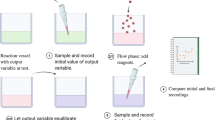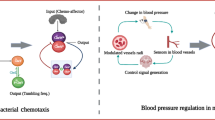Abstract
Biology achieves novel functions like error correction, ultra-sensitivity and accurate concentration measurement at the expense of free energy through Maxwell Demon-like mechanisms. The design principles and free energy trade-offs have been studied for a variety of such mechanisms. In this review, we emphasize a perspective based on dynamical phases that can explain commonalities shared by these mechanisms. Dynamical phases are defined by typical trajectories executed by non-equilibrium systems in the space of internal states. We find that coexistence of dynamical phases can have dramatic consequences for function vs free energy cost trade-offs. Dynamical phases can also provide an intuitive picture of the design principles behind such biological Maxwell Demons.










Similar content being viewed by others
References
Qian, H.: Phosphorylation energy hypothesis: open chemical systems and their biological functions. Annu. Rev. Phys, Chem (2007). doi:10.1146/annurev.physchem.58.032806.104550
Hopfield, J.J.: Kinetic proofreading: a new mechanism for reducing errors in biosynthetic processes requiring high specificity. Proc. Natl. Acad. Sci. USA 71(10), 4135 (1974)
Hopfield, J.J.: The energy relay: a proofreading scheme based on dynamic cooperativity and lacking all characteristic symptoms of kinetic proofreading in DNA replication and protein synthesis. Proc. Natl. Acad. Sci. USA 77(9), 5248 (1980)
Ninio, J.: Kinetic amplification of enzyme discrimination. Biochimie 57(5), 587–595 (1975)
Yuhai, T.: Quantitative modeling of bacterial chemotaxis: signal amplification and accurate adaptation. Ann. Rev. Biophys. 42, 337–359 (2013)
Mehta, P., Schwab, D.J.: Energetic costs of cellular computation. Proc. Natl. Acad. Sci. USA 109(44), 17978–17982 (2012)
Schnakenberg, J.: Network theory of microscopic and macroscopic behavior of master equation systems. Rev. Mod, Phys (1976). doi:10.1103/RevModPhys.48.571
Yuhai, T.: The nonequilibrium mechanism for ultrasensitivity in a biological switch: sensing by Maxwell’s demons. Proc. Natl. Acad. Sci. USA 105(33), 11737–11741 (2008)
Bialek, W., Setayeshgar, S.: Physical limits to biochemical signaling. Proc. Natl. Acad. Sci. USA 102(29), 10040–10045 (2005)
Berg, H.C., Purcell, E.M.: Physics of chemoreception. Biophys. J. 20(2), 193 (1977)
Hartich, D., Barato, A.C., Seifert, U.: Nonequilibrium sensing and its analogy to kinetic proofreading. arXiv (2015). doi:10.1088/1367-2630/17/5/055026
Murugan, A., Huse, D.A., Leibler, S.: Discriminatory proofreading regimes in nonequilibrium systems. Phys. Rev. X 4(2), 021016 (2014)
Lan, G., Sartori, P., Neumann, S., Sourjik, V.: Yuhai, Tu: The energy-speed-accuracy trade-off in sensory adaptation. Nat. Phys. 8(5), 422–428 (2012)
Sartori, P., Pigolotti, S.: Kinetic versus energetic discrimination in biological copying. Phys. Rev. Lett. 110(18), 188101 (2013)
Schnakenberg, J.: Network theory of microscopic and macroscopic behavior of master equation systems. Rev. Mod. Phys. 48(4), 571–585 (1976)
Ehrenberg, M., Blomberg, C.: Thermodynamic constraints on kinetic proofreading in biosynthetic pathways. Biophys. J. 31(3), 333–358 (1980)
Hlavacek, W.S., Redondo, A., Metzger, H., Wofsy, C., Goldstein, B.: Kinetic proofreading models for cell signaling predict ways to escape kinetic proofreading. Proc. Natl. Acad. Sci. USA 98(13), 7295–7300 (2001)
McKeithan, T.W.: Kinetic proofreading in T-cell receptor signal transduction. Proc. Natl. Acad. Sci. USA 92(11), 5042 (1995)
Goldstein, B., Faeder, J.R., Hlavacek, W.S.: Mathematical and computational models of immune-receptor signalling. Nat. Rev. Immunol. 4(6), 445–456 (2004)
François, P., Voisinne, G., Siggia, E.D., Altan-Bonnet, G., Vergassola, M.: Phenotypic model for early T-cell activation displaying sensitivity, specificity, and antagonism. Proc. Natl. Acad. Sci. USA 110(10), E888–E897 (2013)
Blanchard, S.C., Gonzalez, R.L., Kim, H.D., Chu, S., Puglisi, J.D.: tRNA selection and kinetic proofreading in translation. Nat. Struct. Mol. Biol. 11(10), 1008–1014 (2004)
Johansson, M., Lovmar, M., Ehrenberg, M.: Rate and accuracy of bacterial protein synthesis revisited. Curr. Opin. Microbiol. 11(2), 141–147 (2008)
Bar-Ziv, R., Tlusty, T., Libchaber, A.: Protein-DNA computation by stochastic assembly cascade. Proc. Natl. Acad. Sci. USA 99(18), 11589–11592 (2002)
Murugan, A., Huse, D.A., Leibler, S.: Speed, dissipation, and error in kinetic proofreading. Proc. Natl. Acad. Sci. USA 109(30), 12034–12039 (2012)
Yan, J., Magnasco, M.O., Marko, J.F.: A kinetic proofreading mechanism for disentanglement of DNA by topoisomerases. Nature 401(6756), 932–935 (1999)
Sancar, A., Lindsey-Boltz, L.A., Linn, S., Ünsal-Kaçmaz, K.: Molecular mechanisms of mammalian DNA repair and the DNA damage checkpoints (2004). doi:10.1146/annurev.biochem.73.011303.073723
Li, W., Ma, A.: Recent developments in methods for identifying reaction coordinates. Mol. Simul. 40(10–11), 784–793 (2014)
Sontag, E.D.: Structure and stability of certain chemical networks and applications to the kinetic proofreading model of T-cell receptor signal transduction. IEEE Trans. Autom. Control 46(7), 1028–1047 (2001)
Munsky, B., Nemenman, I., Bel, G.: Specificity and completion time distributions of biochemical processes. J. Chem. Phys. 131(23), 235103 (2009)
De Ronde, W.H., Daniels, BC., Sinitsyn, N.A., Nemenman, I., Mugler, A.: Statistical properties of multistep enzyme-mediated reactions (2008). doi:10.1049/iet-syb.2008.0167
Rabinowitz, J.D., Beeson, C., Lyons, D.S., Davis, M.M., McConnell, H.M.: Kinetic discrimination in T-cell activation. Proc. Natl. Acad. Sci. USA 93(4), 1401–1405 (1996)
MacGlashan, D.: Signaling cascades: escape from kinetic proofreading. Proc. Natl. Acad. Sci. USA 98, 6989–6990 (2001)
Vaikuntanathan, S., Gingrich, T.R., Geissler, P.L.: Dynamic phase transitions in simple driven kinetic networks. Phys. Rev. E 89(6), 062108 (2014)
Sinai, Y.G.: A random-walk with random potential. Theory Probab. Appl. 38(2), 382–385 (1993)
Bennett, C.H.: Dissipation-error tradeoff in proofreading. BioSystems 11(2–3), 85–91 (1979)
Qian, H.: Reducing intrinsic biochemical noise in cells and its thermodynamic limit. J. Mol. Biol. (2006). doi:10.1016/j.jmb.2006.07.068
Touchette, H.: The large deviation approach to statistical mechanics. Phys. Rep. 478(13), 1–69 (2009)
Depken, M., Parrondo, J.M.R., Grill, S.W.: Intermittent transcription dynamics for the rapid production of long transcripts of high fidelity. Cell Rep. 5(2), 521–530 (2013)
Süel, G.M., Garcia-Ojalvo, J., Liberman, L.M., Elowitz, M.B.: An excitable gene regulatory circuit induces transient cellular differentiation. Nature 440(7083), 545–550 (2006)
Lebowitz, J.L., Spohn, H.: A GallavottiCohen-type symmetry in the large deviation functional for stochastic dynamics. J. Stat. Phys. 95, 333–365 (1999)
Chetrite, R., Touchette, H.: Nonequilibrium microcanonical and canonical ensembles and their equivalence. Phys. Rev. Lett. 111, 120601 (2013)
Jack, R.L., Sollich, P.: Large deviations and ensembles of trajectories in stochastic models. Progr. Theor. Phys. 184, 304–317 (2010)
Dellago, C., Bolhuis, P.G., Csajka, F.S.: Transition path sampling and the calculation of rate constants. J. Chem. 108(5), 1964 (1998)
Garrahan, J.P., Jack, R.L., Lecomte, V., Pitard, E., van Duijvendijk, K., van Wijland, F.: Dynamical first-order phase transition in kinetically constrained models of glasses. Phys. Rev. Lett. 98(19), 195702 (2007)
Weber, J.K., Jack, R.L., Pande, V.S.: Emergence of glass-like behavior in markov state models of protein folding dynamics. J. Am. Chem. Soc. 135(15), 5501–5504 (2013)
Hurtado, Pablo I., Garrido, Pedro L.: Spontaneous symmetry breaking at the fluctuating level. Phys. Rev. Lett. 107(18), 180601 (2011)
Derrida, B., Mecheri, K., Pichard, J.L.: Lyapounov exponents of products of random matrices: weak disorder expansion.-application to localisation. J. Phys. 48(5), 733–740 (1987)
Holy, T.E., Leibler, S.: Dynamic instability of microtubules as an efficient way to search in space. Proc. Natl. Acad. Sci. USA 91(12), 5682–5685 (1994)
Bowne-Anderson, H., Zanic, M., Kauer, M., Howard, J.: Microtubule dynamic instability: a new model with coupled GTP hydrolysis and multistep catastrophe. Bioessays 35(5), 452–461 (2013)
Kirschner, M.W., Gerhart, J.C.: The Plausibility of Life: Resolving Darwin’s Dilemma. Yale University Press, (2006)
Wystrach, A., Schwarz, S., Baniel, A., Cheng, K.: Backtracking behaviour in lost ants: an additional strategy in their navigational toolkit. Proc. R. Soc. B 280(1769), 20131677–20131677 (2013)
Bénichou, O., Loverdo, C., Moreau, M.: Intermittent search strategies. Rev. Mod, Phys (2011). doi:10.1103/RevModPhys.83.81
von Hippel, P.H., Berg, O.G.: Facilitated target location in biological systems. J. Biol, Chem (1989). http://www.jbc.org/content/264/2/675.abstract
Zandarashvili, L., Esadze, A., Vuzman, D., Kemme, C.A., Levy, Y., Iwahara, J.: Balancing between affinity and speed in target DNA search by zinc-finger proteins via modulation of dynamic conformational ensemble. Proc. Natl. Acad. Sci. USA 112(37), E5142–E5149 (2015)
Liao, Y., Schroeder, J.W., Gao, B., Simmons, L.A., Biteen, J.S.: Single-molecule motions and interactions in live cells reveal target search dynamics in mismatch repair. Proc. Natl. Acad. Sci. USA 112, E6898–E6906 (2015)
Rao, R., Peliti, L.: Thermodynamics of accuracy in kinetic proofreading: dissipation and efficiency trade-offs. arXiv (2015). doi:10.1088/1742-5468/2015/06/P06001
Ling, J., Roy, H., Ibba, M.: Mechanism of tRNA-dependent editing in translational quality control. Proc. Natl. Acad. Sci. USA 104(1), 72–77 (2007)
Lang, A.H., Fisher, C.K., Mora, T., Mehta, P.: Thermodynamics of statistical inference by cells. Phys. Rev. Lett. 113(14), 148103 (2014)
Endres, R.G., Wingreen, N.S.: Maximum likelihood and the single receptor. Phys. Rev. Lett. 103(15), 158101 (2009)
Mora, T., Wingreen, N.S.: Limits of sensing temporal concentration changes by single cells. Phys. Rev. Lett. 104(24), 248101 (2010)
Mora, T.: Physical limit to concentration sensing amid spurious ligands. Phys. Rev. Lett. 115(3), 038102 (2015)
Govern, C.C., ten Wolde, P.R.: Optimal resource allocation in cellular sensing systems. Proc. Natl. Acad. Sci. USA 111(49), 17486–17491 (2014)
Barato, A.C., Hartich, D., Seifert, U.: Information-theoretic versus thermodynamic entropy production in autonomous sensory networks. Phys. Rev. E 87(4), 042104 (2013)
Barato, A.C., Hartich, D., Seifert, U.: Efficiency of cellular information processing. New J. Phys. 16(10), 103024 (2014)
Baylor, D.: How photons start vision. Proc. Natl. Acad. Sci. USA 93(2), 560–565 (1996)
Lin, J., Chew, J., Chockanathan, U., Rust, M.J.: Mixtures of opposing phosphorylations within hexamers precisely time feedback in the cyanobacterial circadian clock. Proc. Natl. Acad. Sci. USA 111(37), E3937–E3945 (2014)
Korobkova, E.A., Emonet, T., Park, H., Cluzel, P.: Hidden stochastic nature of a single bacterial motor. Phys. Rev. Lett. 96, 058105 (2006)
Jean-Benoît, L., Paul, F.: Chemodetection in fluctuating environments: receptor coupling, buffering, and antagonism. Proc. Natl. Acad. Sci. USA 112(6), 1898–1903 (2015)
Acknowledgments
We gratefully acknowledge useful discussions with Michael Brenner, Aaron Dinner, Todd Gingrich, David Huse, Stan Leibler, Pankaj Mehta, Matthew Pinson, Luca Peliti, Mike Rust, Mikhail Tikhonov and Thomas Witten. SV acknowledges funding from the University of Chicago.
Author information
Authors and Affiliations
Corresponding author
Rights and permissions
About this article
Cite this article
Murugan, A., Vaikuntanathan, S. Biological Implications of Dynamical Phases in Non-equilibrium Networks. J Stat Phys 162, 1183–1202 (2016). https://doi.org/10.1007/s10955-015-1445-0
Received:
Accepted:
Published:
Issue Date:
DOI: https://doi.org/10.1007/s10955-015-1445-0




